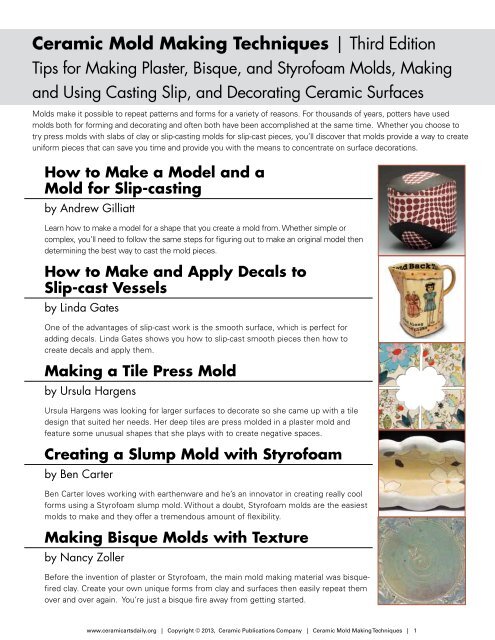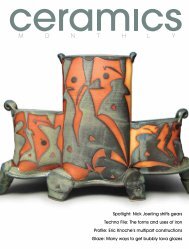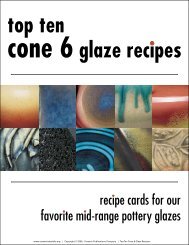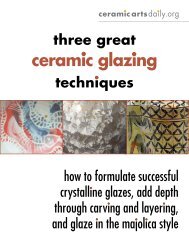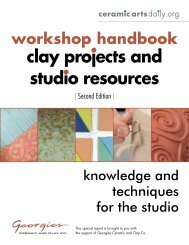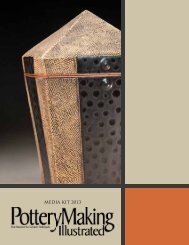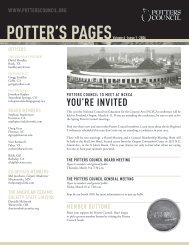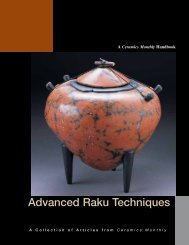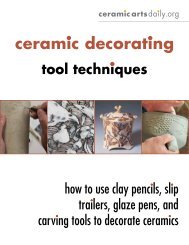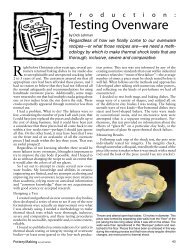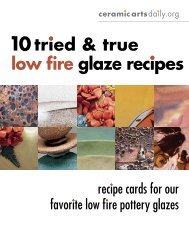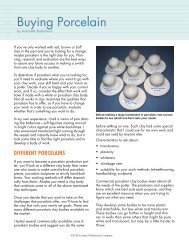mold making - Ceramic Arts Daily
mold making - Ceramic Arts Daily
mold making - Ceramic Arts Daily
You also want an ePaper? Increase the reach of your titles
YUMPU automatically turns print PDFs into web optimized ePapers that Google loves.
<strong>Ceramic</strong> Mold Making Techniques | Third Edition<br />
Tips for Making Plaster, Bisque, and Styrofoam Molds, Making<br />
and Using Casting Slip, and Decorating <strong>Ceramic</strong> Surfaces<br />
Molds make it possible to repeat patterns and forms for a variety of reasons. For thousands of years, potters have used<br />
<strong>mold</strong>s both for forming and decorating and often both have been accomplished at the same time. Whether you choose to<br />
try press <strong>mold</strong>s with slabs of clay or slip-casting <strong>mold</strong>s for slip-cast pieces, you’ll discover that <strong>mold</strong>s provide a way to create<br />
uniform pieces that can save you time and provide you with the means to concentrate on surface decorations.<br />
How to Make a Model and a<br />
Mold for Slip-casting<br />
by Andrew Gilliatt<br />
Learn how to make a model for a shape that you create a <strong>mold</strong> from. Whether simple or<br />
complex, you’ll need to follow the same steps for figuring out to make an original model then<br />
determining the best way to cast the <strong>mold</strong> pieces.<br />
How to Make and Apply Decals to<br />
Slip-cast Vessels<br />
by Linda Gates<br />
One of the advantages of slip-cast work is the smooth surface, which is perfect for<br />
adding decals. Linda Gates shows you how to slip-cast smooth pieces then how to<br />
create decals and apply them.<br />
Making a Tile Press Mold<br />
by Ursula Hargens<br />
Ursula Hargens was looking for larger surfaces to decorate so she came up with a tile<br />
design that suited her needs. Her deep tiles are press <strong>mold</strong>ed in a plaster <strong>mold</strong> and<br />
feature some unusual shapes that she plays with to create negative spaces.<br />
Creating a Slump Mold with Styrofoam<br />
by Ben Carter<br />
Ben Carter loves working with earthenware and he’s an innovator in creating really cool<br />
forms using a Styrofoam slump <strong>mold</strong>. Without a doubt, Styrofoam <strong>mold</strong>s are the easiest<br />
<strong>mold</strong>s to make and they offer a tremendous amount of flexibility.<br />
Making Bisque Molds with Texture<br />
by Nancy Zoller<br />
Before the invention of plaster or Styrofoam, the main <strong>mold</strong> <strong>making</strong> material was bisquefired<br />
clay. Create your own unique forms from clay and surfaces then easily repeat them<br />
over and over again. You’re just a bisque fire away from getting started.<br />
www.ceramicartsdaily.org | Copyright © 2013, <strong>Ceramic</strong> Publications Company | <strong>Ceramic</strong> Mold Making Techniques | 1


